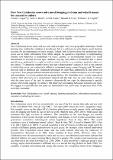Files in this item
How New Caledonian crows solve novel foraging problems and what it means for cumulative culture
Item metadata
| dc.contributor.author | Logan, Corina J. | |
| dc.contributor.author | Breen, A.J. | |
| dc.contributor.author | Taylor, Alex H. | |
| dc.contributor.author | Gray, Russell D. | |
| dc.contributor.author | Hoppitt, William J. E. | |
| dc.date.accessioned | 2016-08-23T09:30:17Z | |
| dc.date.available | 2016-08-23T09:30:17Z | |
| dc.date.issued | 2016-03 | |
| dc.identifier | 212459218 | |
| dc.identifier | 4802bd86-e441-4f4b-9466-a950266e35b1 | |
| dc.identifier | 84939233704 | |
| dc.identifier | 000371534300006 | |
| dc.identifier.citation | Logan , C J , Breen , A J , Taylor , A H , Gray , R D & Hoppitt , W J E 2016 , ' How New Caledonian crows solve novel foraging problems and what it means for cumulative culture ' , Learning and Behavior , vol. 44 , no. 1 , pp. 18-28 . https://doi.org/10.3758/s13420-015-0194-x | en |
| dc.identifier.issn | 1543-4494 | |
| dc.identifier.uri | https://hdl.handle.net/10023/9361 | |
| dc.description | The authors are grateful to their funders: the SAGE Center for the Study of the Mind at the University of California Santa Barbara and the National Geographic Society/Waitt Grants Program (CJL), a Rutherford Discovery Fellowship from the Royal Society of New Zealand (AHT), the Marsden Fund (RG), and a BBSRC grant (WH; BB/I007997/1). | en |
| dc.description.abstract | New Caledonian crows make and use tools, and tool types vary over geographic landscapes. Social learning may explain the variation in tool design, but it is unknown to what degree social learning accounts for the maintenance of these designs. Indeed, little is known about the mechanisms these crows use to obtain information from others, despite the question’s importance in understanding whether tool behavior is transmitted via social, genetic, or environmental means. For social transmission to account for tool-type variation, copying must utilize a mechanism that is action specific (e.g., pushing left vs. right) as well as context specific (e.g., pushing a particular object vs. any object). To determine whether crows can copy a demonstrator’s actions as well as the contexts in which they occur, we conducted a diffusion experiment using a novel foraging task. We used a nontool task to eliminate any confounds introduced by individual differences in their prior tool experience. Two groups had demonstrators (trained in isolation on different options of a four-option task, including a two-action option) and one group did not. We found that crows socially learn about context: After observers see a demonstrator interact with the task, they are more likely to interact with the same parts of the task. In contrast, observers did not copy the demonstrator’s specific actions. Our results suggest it is unlikely that observing tool-making behavior transmits tool types. We suggest it is possible that tool types are transmitted when crows copy the physical form of the tools they encounter. | |
| dc.format.extent | 25108344 | |
| dc.language.iso | eng | |
| dc.relation.ispartof | Learning and Behavior | en |
| dc.subject | New Caledonian crow | en |
| dc.subject | Social learning | en |
| dc.subject | Learning mechanisms | en |
| dc.subject | information transmission | en |
| dc.subject | Cumulative technological culture | en |
| dc.subject | QL Zoology | en |
| dc.subject | DAS | en |
| dc.subject.lcc | QL | en |
| dc.title | How New Caledonian crows solve novel foraging problems and what it means for cumulative culture | en |
| dc.type | Journal article | en |
| dc.contributor.sponsor | BBSRC | en |
| dc.contributor.institution | University of St Andrews. School of Biology | en |
| dc.identifier.doi | https://doi.org/10.3758/s13420-015-0194-x | |
| dc.description.status | Peer reviewed | en |
| dc.identifier.url | http://link.springer.com/article/10.3758%2Fs13420-015-0194-x#SupplementaryMaterial | en |
| dc.identifier.grantnumber | BB/I007997/1 | en |
This item appears in the following Collection(s)
Items in the St Andrews Research Repository are protected by copyright, with all rights reserved, unless otherwise indicated.

